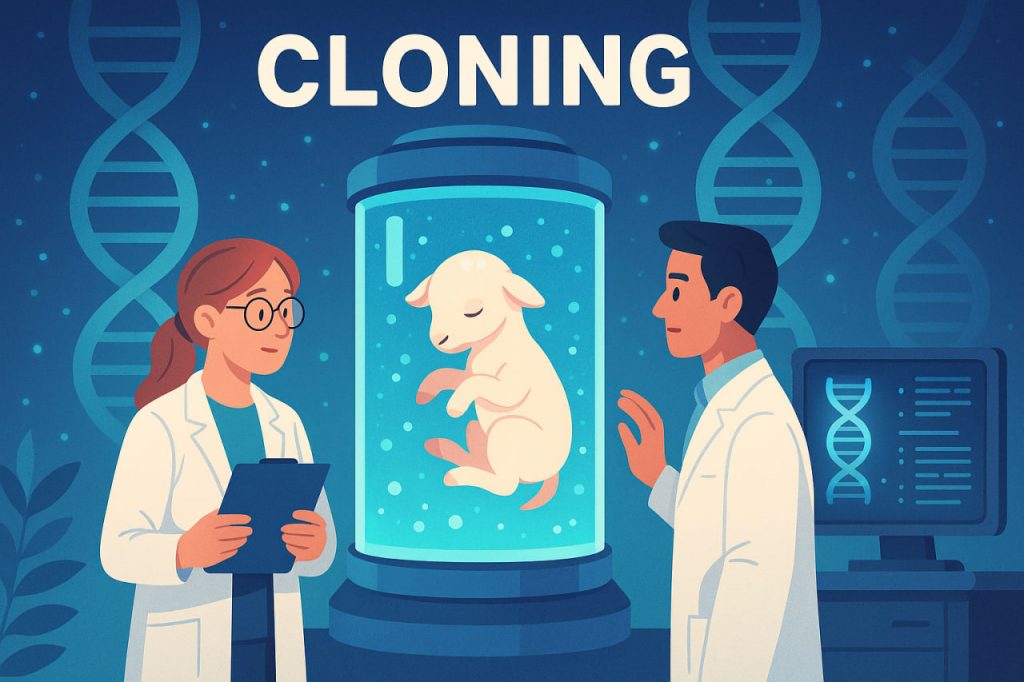Cloning is one of the most fascinating and controversial fields in modern biology. It challenges our understanding of identity, reproduction, and the boundaries of life itself. At its core, cloning is the process of creating genetically identical copies of living organisms, cells, or DNA. Once considered pure science fiction, cloning has become a real scientific tool—used in medicine, agriculture, and conservation. Yet, the ethical and philosophical questions it raises remain as complex as the technology itself.
The Origins of Cloning Science
The idea of cloning began to take shape in the early 20th century, when scientists discovered that genetic information is stored in DNA. The first experiments involved dividing frog embryos in the 1950s to create identical tadpoles. However, the true breakthrough came in 1996, when Scottish researchers successfully cloned a sheep named Dolly using a process called somatic cell nuclear transfer (SCNT). Dolly proved that an adult cell’s genetic material could be reprogrammed to develop into a whole organism. Her birth opened an entirely new chapter in biology and ethics.
How Cloning Works
In reproductive cloning, scientists remove the nucleus from an egg cell and replace it with the nucleus of a somatic (body) cell from the organism being cloned. The egg, now containing the donor’s DNA, is stimulated to divide and grow into an embryo, which is then implanted into a surrogate mother. If the process succeeds, the offspring is an almost exact genetic copy of the original donor.
Another approach, therapeutic cloning, aims not to create entire organisms but to produce stem cells—the body’s “master cells.” These can be used to generate tissues and organs for medical treatment, such as repairing damaged hearts or regenerating nerves.
Applications of Cloning
Cloning has far-reaching potential across several scientific fields:
- Medicine: Therapeutic cloning could revolutionize organ transplantation, providing tissues genetically identical to the patient, eliminating rejection risks. It could also help study genetic diseases and develop personalized treatments.
- Agriculture: Farmers use cloning to reproduce animals with desirable traits—like higher milk production or disease resistance—ensuring uniform quality and performance.
- Conservation: Cloning endangered or even extinct species, such as the woolly mammoth or northern white rhino, is becoming a reality. These efforts combine cloning with genetic sequencing and artificial reproduction to restore lost biodiversity.
- Pharmaceuticals: Cloned animals are used to produce human-compatible proteins, hormones, and antibodies for medical treatments.
Ethical and Moral Questions
While cloning offers great promise, it also raises profound ethical issues. Should humans be cloned? What defines individuality if two organisms share identical DNA? Most nations have banned human reproductive cloning, citing moral, social, and psychological concerns. Critics argue that cloning could devalue human life and lead to exploitation or identity crises. Supporters, however, believe that controlled scientific research—especially therapeutic cloning—can save lives and expand our understanding of biology.
Future Prospects
In the decades to come, cloning may merge with artificial intelligence, genetic editing (CRISPR), and synthetic biology, creating new forms of life that never existed before. Researchers are already working on cloning cells to grow artificial organs and create sustainable food sources, such as lab-grown meat. The line between natural and artificial life is blurring rapidly. While full human cloning remains prohibited, partial cloning—using human cells for regenerative medicine—continues to advance. The future will depend not only on what we can do, but also on what we decide is right to do.
Interesting Facts
- Dolly the sheep lived for six years and had normal offspring, proving cloned animals can reproduce naturally.
- Scientists have successfully cloned cats, dogs, horses, camels, and even monkeys.
- In 2020, the endangered black-footed ferret was cloned in the United States using frozen DNA from the 1980s.
- Some companies now offer pet cloning services for over $25,000.
- Cloning success rates remain low—only about 1% to 5% of cloned embryos develop into healthy animals.
Glossary
- Cloning – The creation of genetically identical copies of a living organism or its cells.
- DNA (Deoxyribonucleic Acid) – The molecule carrying genetic information in all living things.
- Somatic Cell – Any body cell that is not involved in reproduction.
- Somatic Cell Nuclear Transfer (SCNT) – The process used to create clones by transferring a nucleus into an egg cell.
- Therapeutic Cloning – The creation of cloned cells or tissues for medical use rather than full organisms.
- Stem Cells – Undifferentiated cells that can develop into any type of tissue.
- Genetic Engineering – The direct modification of an organism’s DNA for desired traits.
- Biodiversity – The variety of life on Earth, from genes to ecosystems.
- CRISPR – A modern gene-editing technique that allows precise DNA modifications.
- Synthetic Biology – The field that combines biology and technology to design new forms of life.


